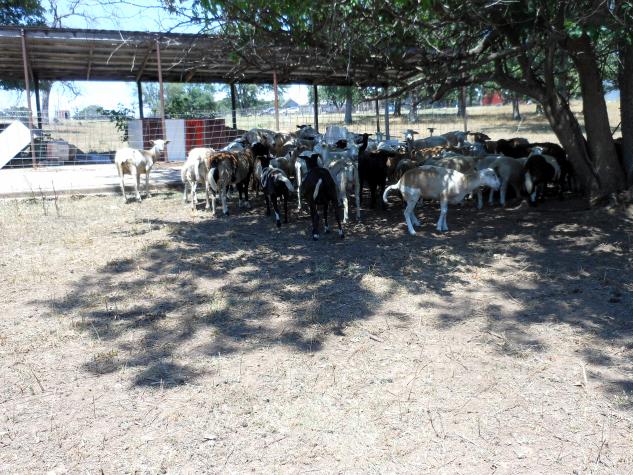OSCEOLA, Mo. – As the summer months set in, sheep and goat producers should watch their animals for heat stress, says David Brown, University of Missouri small ruminant specialist. Although sheep and goats can tolerate heat better than other livestock species, long-term exposure might have devastating effects on the health and performance of the animals.
Reduced dry matter intake during heat stress can lead to a range of negative effects on animal performance, including decreased energy intake (energy deficit), decreased body condition and potential weight loss, nutrient imbalance and reduced milk production in lactating ewes/does.
Heat stress occurs when the animals are unable to regulate their body temperatures. Animals may reach a point where they cannot dissipate enough heat to maintain body thermal balance.
Temperature humidity index (THI) is the best measure of livestock environmental stress, as it gives a more accurate measure of heat stress, Brown says. Heat stress is considered severe in sheep and goats when the THI is between 84 and 86 F. A THI above 86 F is considered extreme. The National Weather Service has forecast THI of 95-100 F within the coming weeks.
Open-mouth panting is an important visual indicator of severe heat stress in sheep and goats. Producers may employ a panting assessment to determine the level of discomfort in the flock/herd as follows:
• Mild heat stress. Animals may show mild to fast panting, but with a closed mouth. Rapid chest movements will be easily observable.
• Moderate heat stress. Animals show fast panting, progressing to mouth slightly open, but the tongue is not extended beyond the lips. Rapid chest movements will be easily observable.
• Severe heat stress. Rapid, open-mouth panting will be seen, with the neck extended, head held up and tongue extended.
• Extreme heat stress. Open-mouth panting will be seen, with the tongue fully extended and the head often lowered. Deeper breathing will occur, with a reduction in the panting rate for short periods.
Other signs to look for are crowding at water source, shade seeking, increased respiratory rate, immobility or staggering, and drooling.
“Producers should adopt a multidisciplinary approach to lessen the impact of high heat and humidity,” says Brown. Consider these strategies:
• Access to plenty of clean, cool water is extremely important during hot weather. On average, sheep or goats will drink 1-2 gallons of water per day. Lactating animals will drink more. A research report from University of Maryland Extension showed that sheep drink 12 times more water when it is dry and the temperature exceeds 100 F.
• Sheep should not be sheared in extreme heat. A thick fleece acts as insulation against temperature changes. It has been documented that sheep with a 1-inch fleece tolerated higher temperatures than sheep with less wool.
• Livestock should not graze during the heat of the day. Encourage early morning or late evening grazing to maintain normal feed intake.
• Provide nutrient-dense diets during periods of high heat and/or humidity. Less body heat is produced when livestock are fed grain rather than poor-quality forages. Feed additives such as live yeast and vitamins C and E are essential to offset the impact of heat stress.
• Provide shade in the form of Quonset huts, polydomes or carports. Mature trees are a low-cost option and provide excellent shade and shelter for grazing animals. When livestock are housed in barns, an evaporative cooling system with water in the form of mist or sprinkling is recommended, but do not let these areas become wet and muddy.
• Monitor for signs of distress. Clinical signs of heat stress include continual panting, rapid breathing, weakness, inability to stand and rectal temperature over 105 F. Death may occur with a rectal temperature over 107 F as the animal’s cells begin to degenerate.
Brown has recently updated the MU Extension publication “Management of Sheep and Goats Through Drought,” which is available free online at extension.missouri.edu/publications/g2618.
For more information on heat stress management in small ruminants, contact David Brown at davidbrown@missouri.edu or 417-646-2419.
